Collecting Robert A. Heinlein
Over the past few weeks I’ve discussed some interesting patterns I’ve seen among paperback SF and fantasy collectors. These are hardly profound observations — they’re obvious to anyone who’s been collecting science fiction paperbacks for the past twenty years. But it has been interesting to see some well-known trends quantified.
The catalyst for all this was a sequence of similar online auctions by a single seller, for roughly comparable lots of paperback books by some of the most popular genre writers of the 20th Century. All were in virtually perfect shape — the kind of auctions that bring out die-hard collectors. The results were fairly predictable.
| 32 books by Arthur C. Clarke | $27.00 |
| 35 books by Isaac Asimov | $82.17 |
| 56 books by Philip K. Dick | $536.99 |
Click on the links to see the actual books in question. What we’re seeing here is a pretty fair representation of the popularly and demand for each of these writers some two to three decades after their deaths. So while there’s a wide disparity in prices, that’s to be expected. But I think the really interesting result came from the Heinlein auction.
Most casual observers, of course, are startled by that Phil Dick auction (especially since, unlike the other two, the books weren’t virtually brand new). But that $537 price tag is not really a surprise for anyone who’s been collecting SF for any length of time.
Most high-value collectors are concerned with first editions, and especially first editions of rare books. Asimov and Clarke had plenty of hardcover first editions, and the paperback reprints of those books (especially in later decades) became bestsellers. So while early first editions of Foundation and Childhood’s End still command high prices today, the 12th printing of the fifth paperback edition in 1985 doesn’t, regardless of what shape it’s in. Those bidding on the Asimov and Clarke collections above are folks, like me, who would love to have pristine copies of some of their favorite books by best-loved authors, and especially cherish the editions they first read them in.
Philip K. Dick is a totally different ball game. Virtually none of his books first appeared in hardcover, and he never had a bestseller in his life. The first editions of his 40+ novels were unassuming paperbacks with low print runs from publishers like Ace and Bantam, and not many survive today. Asimov and Clarke’s fame peaked while they were alive, but Dick has experienced a growing renaissance since his death, and he’s most popular now than ever.
Factor all of that together, and you end up paying, on average, nearly 10 times more for a typical Philip K. Dick paperback than an Asimov paperback — and 20 times more than a Clarke paperback. And that’s exactly what you see reflected in the table of prices above.
None of this is surprising to those with a rudimentary grasp of the concepts of supply & demand. In fact, with just these three examples, you can probably fashion a decent enough yardstick to spitball the selling prices of others collections of similar vintage.
What the hell… let’s try it out. The picture immediately above is another recent auction, by the same seller, for a pristine set of 51 Robert A. Heinlein books (click on the image to see just how flawless these books are).
This should be a cinch. None of these are first editions. There are no rare books here — and in fact, these are all late editions, so there’s really no truly vintage books here at all — so we’re clearly looking at an Asimov-Clarke situation, rather than another Phil Dick. Though Heinlein has held up pretty well, and there are more books here than in the Asimov or Clarke collections, so I would tend towards the high end of our scale (say, 50% above the selling price of the Asimov collection, or slightly over $2/book).
So going into the auction. my estimate of final selling price was in this ball park:
| 51 books by Robert A. Heinlein | $80 – $125 est |
In fact, when the auction closed on October 5th, the final bid was more than twice my estimate.
| 51 books by Robert A. Heinlein | $255.00 |
Where did we go wrong?
We went wrong in the usual way — by underestimating Robert A. Heinlein.
Truthfully, I’ve never been much of a Heinlein fan. I’ve never enjoyed him the way I do Asimov or Clarke, for example. I thought Stranger in a Strange Land was highly overrated, and despite multiple attempts I could never finish The Moon is a Harsh Mistress.
On the other hand, I thought Orphans in the Sky was brilliant, as was much of his short fiction. If I were paddling towards a long stay on a desert island and could only grab one Heinlein book from ship’s stores before they went down, I would grab his monumental future history collection The Past Through Tomorrow without hesitation.
The point is that I don’t have the emotional connection to Heinlein that his true fans do — and he has a lot of true fans, even today. While many collectors talk about “The Big Three” of Asimov, Clarke and Heinlein, the first SF writers to consistently break into bestselling lists, many serious fans – such as Charles N. Brown, founding editor of Locus — argued that the other two were never as popular or as important as Heinlein.
Whatever your opinion on their relative merits, it’s hard to argue against the fact that Heinlein has endured longer than Asimov and Clarke… and virtually any other Twentieth Century genre writer except H.P. Lovecraft, J.R.R. Tolkien, and Philip K. Dick. Much of his work is still in print in mass market paperback today.
Even more impressively, Heinlein has stayed popular and in print with virtually no help from the film industry. With the notable exception of 1997’s Starship Troopers (and the much lesser-known films The Puppet Masters, from 1994, and Predestination, 2014), Heinlein has endured chiefly on his own steam.
It’s too early to tell if Heinlein will experience a 21st Century Renaissance on the scale of Dick and Tolkien, or if he’s simply held on longer than Asimov and Clarke, and will eventually slide into obscurity. There are already signs that some of his midlist paperbacks, kept in print for the last 30 years chiefly by Del Rey and Baen, are beginning to go out of print. Likely his fate, like that of Dick and Tolkien, will be decided by Hollywood. If filmmakers begin to mine Heinlein the way they have those two (and there’s a great deal to mine), Heinlein could be discovered by many generations to come.
Our other titles in the Collecting series here at Black Gate include:
Collecting Karl Edward Wagner
Collecting Robert A. Heinlein
Collecting Philip K. Dick
Collecting Arthur C. Clarke
Collecting Isaac Asimov
Collecting Lovecraft, Part I
Collecting Lovecraft, Part II
Collecting Lovecraft, Part III: The Arkham Hardcovers
The Collections of Tanith Lee
The Novels of Tanith Lee: The Wars of Vis
James Bond in Outer Space: The Croyd Spacetime Maneuvres Novels of Ian Wallace
Clones, Deep Space Ships, and Surviving the Apocalypse on a Submarine: The Pocket Richard Cowper
Below are a few more close-ups of assorted Heinlein paperback collections. Enjoy. As always, click for bigger versions.
See all of our Vintage Treasure posts here.
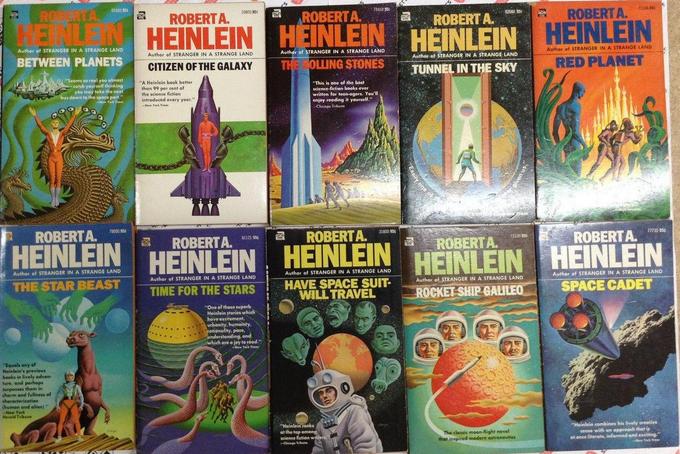
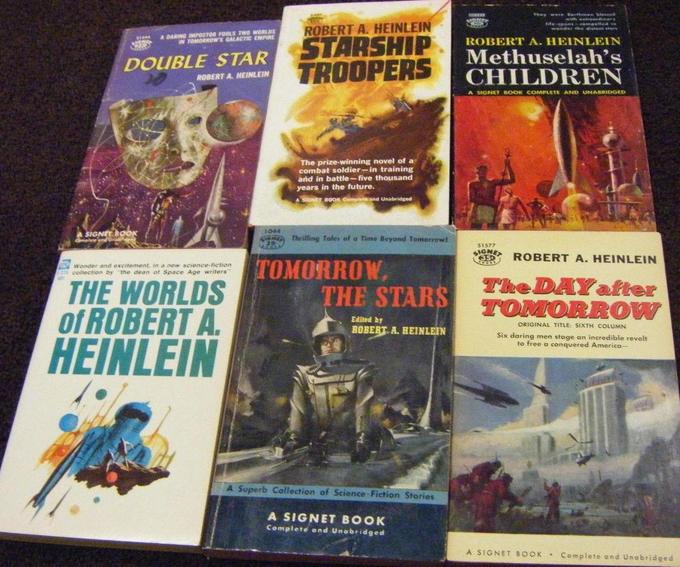
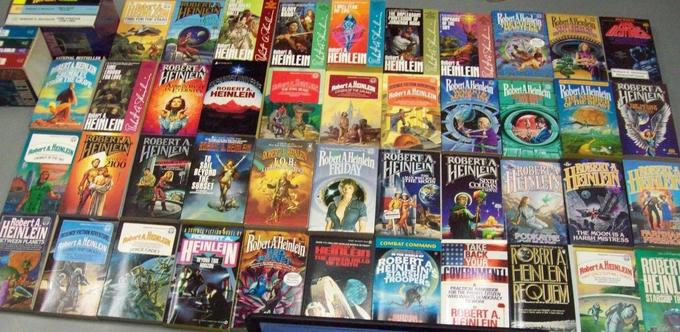
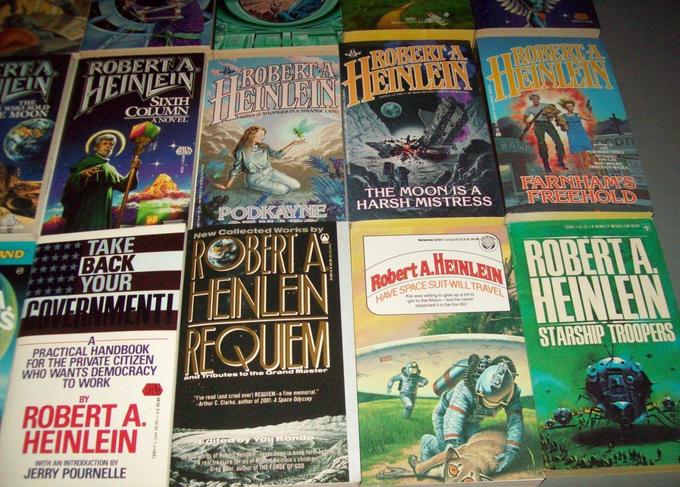
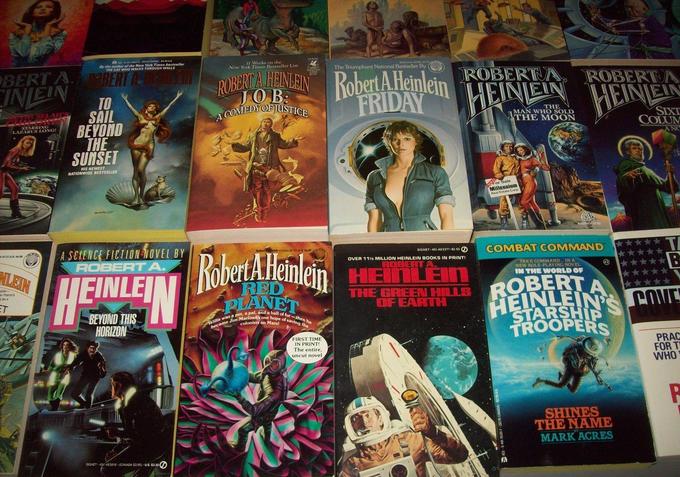
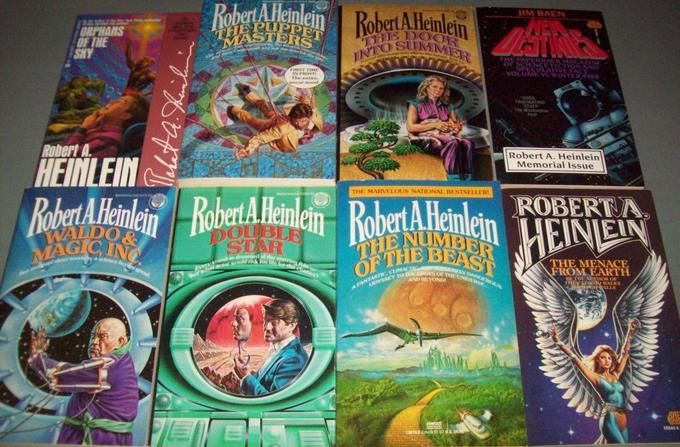
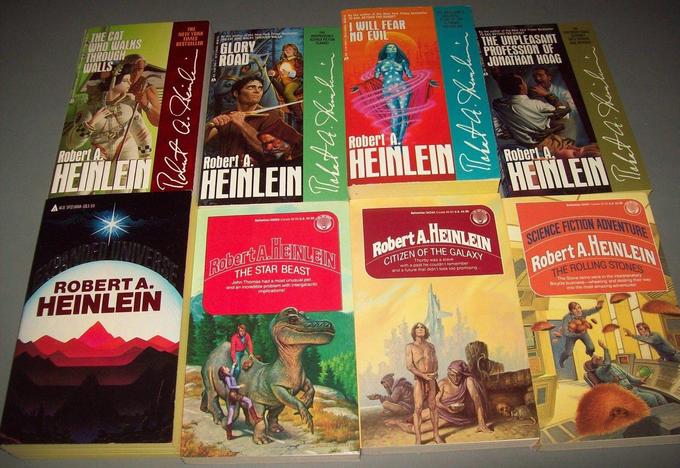
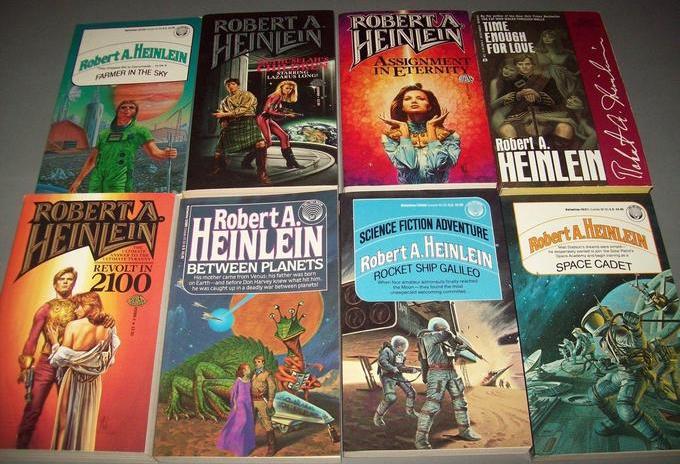
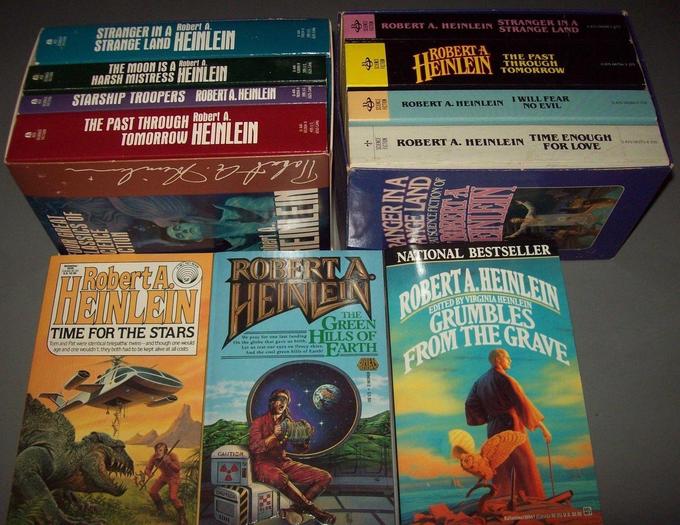
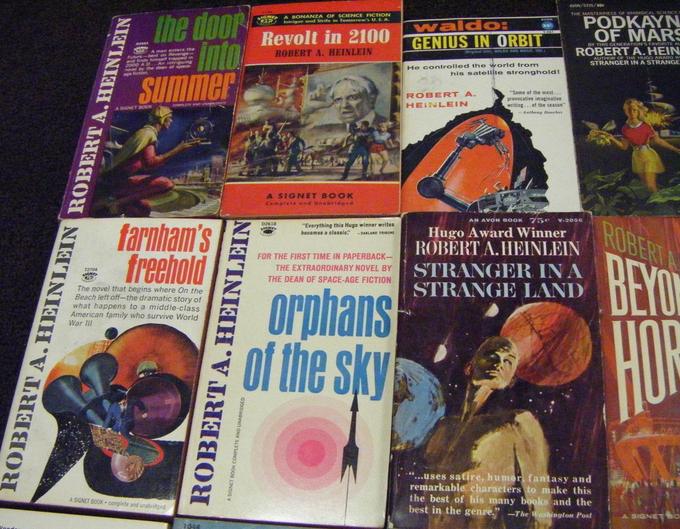
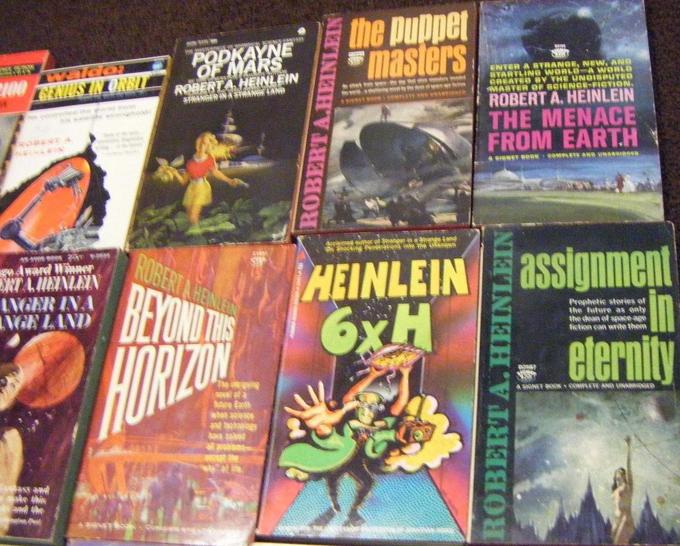
Dad had a fairly extensive Heinlein collection, which I started raiding in, I think, 2nd grade. (Now most of them are on my shelves.) I recognize many of those Ace covers in the first picture — that edition of Red Planet was my first.
Interestingly, I only recently figured out, based on the print dates, that he must’ve bought those particular copies after I was born — I had always thought they were from his teenage years or something. (I asked him about it and he didn’t really remember either.)
After all the flack I’ve heard P.K.D. get over the years, down to his writing skills being called “pedestrian”, these prices are pretty surprising. I’m not surprised about Heinlein, though. He was always a favorite.
God, I love those Steele Savage covers in the first photo. I had – and still have – all of those editions (acquired when I was in the 7th and 8th grades), and would even now count at least five of those novels as among my all-time SF favorites.
Thanks for another interesting post in this “series”…
My experiences as teen we’re similar: Enjoyed Clarke the most, loved Foundation, but couldn’t read much other Asimov, couldn’t get into Heinlein much.
Discovered Man in a High Castle and it blew me away… I need to read it again.
And much as I have enjoyed a number of movie adaptations of PKD, the recent adaptation of Heinlein’s Predestination was one of the most amazing movies I’ve seen in decades… Cant recommend it highly enough!
Impressive collection none the less. It makes me wonder if this seller is just doing a clean-up and selling off his or her collection piecemeal or if there is a niche business opportunity for the compulsive swap meet / garage sale etc purveyor to build up author specific collections and sell them off to someone who wants such a collection but does not wish to do the endless one by one searching?
I am enjoying this series of insights John, please keep them coming. I am keen to see how Philip Jose Farmer stacks up?
[…] (8) COLLECTING HEINLEIN. Black Gate’s John ONeill compares the collectible paperback market for science fiction’s Big Three – Asimov, Clarke and Heinlein – and comes away surprised by the demand for Heinlein. […]
> Dad had a fairly extensive Heinlein collection, which I started raiding in, I think, 2nd grade…
> Red Planet was my first.
Joe,
You were a pretty precocious kid to be reading Heinlein in Second Grade!
And yeah, Red Planet was my intro to Heinlein too. I read it in Elementary school (but definitely not Second Grade!)
> After all the flack I’ve heard P.K.D. get over the years, down to his writing skills being called “pedestrian”,
> these prices are pretty surprising.
CMR,
I don’t think the demand for Dick is greater than for Heinlein — far from it. But Dick wasn’t nearly as popular as Heinlein in the 50s-70s, so his print runs were far smaller. That’s a bit part of what’s driving his prices up.
> I’m not surprised about Heinlein, though. He was always a favorite.
I keep underestimating Heinlein fandom. It still surprises me that he’s as popular as he is, almost 30 years after his death.
> God, I love those Steele Savage covers in the first photo.
Thomas,
OK, I have to admit I’ve never heard of Steele Savage. But I just checked, and you’re quite right — it looks like he (and Davis Meltzer) did the covers for all the Ace Heinlein reprints in the early 70s… in fact, it looks like Savage did all the covers in the first photo above except Citizen of the Galaxy and Space Cadet, which were both done by Meltzer.
I don’t usually collect cover artists, but I have to admit those Ace reprints make an extremely handsome set all together like that.
> Enjoyed Clarke the most, loved Foundation, but couldn’t read much other Asimov, couldn’t get into Heinlein much.
AWA,
You didn’t enjoy I, Robot? I always thought that was some of Asimov’s strongest early work.
> And much as I have enjoyed a number of movie adaptations of PKD, the recent adaptation of Heinlein’s
> Predestination was one of the most amazing movies I’ve seen in decades… Cant recommend it highly enough!
Indeed — I bought the Blu-ray a few months ago, and was very impressed. It’s the kind of film you immediately pop back into the player to watch again. 🙂
> It makes me wonder if this seller is just doing a clean-up and selling off his or her collection piecemeal…
Tiberius,
I bought both the Asimov and Clarke lots and, while I can’t say for sure, I’m reasonably confident that these were all part of the same original collection. They are all virtually flawless, and they look like they just came off bookstore shelves yesterday. I buy collections all the time, and it would take more years than I can fathom to put together a flawless collection like this. There must have been a single collector who gathered them all together.
> I am enjoying this series of insights John, please keep them coming. I am keen to see how Philip Jose Farmer stacks up?
Glad you’re enjoying them! I have the next 2-3 lined up, and PJF was not in the mix, but you’re absolutely right that he deserves to be.
I came across STARSHIP TROOPERS in grade school and loved it, then read some of the short story collections and was off and running. Like the juveniles a lot, and still do. I have most of the books shown, the majority bought new.
For me it was Clarke, then Heinlein, then Asimov. I didn’t read any Dick until I was in college. If I were grabbing books in a hurry to that island, it would be Clarke’s CHILDHOOD’S END and COMPLETE STORIES OF, then the Heinlein story collection you name.
> If I were grabbing books in a hurry to that island, it would be Clarke’s CHILDHOOD’S END
> and COMPLETE STORIES OF, then the Heinlein story collection you name.
A short story man! That’s what I like to see. We need to stick together. 🙂
Hmmm…. now feel like going over my Heinlien to see what I missed, not to collect but to read.
Most of my Heinlein are the 70s “Arty” covers Don’t see any here, r they collectable? Prolly read to low quality in my hands tho- I discovered him in the 80s but bought the books in the used bookstores so I missed most of the “Heinlein Renaissance” prints with high quality art covers. Cept Friday, HAD to have that cover – in a way as hawt as Boris’s cover for Norman’s “Assassin of GOR”;-)
Oh, Friday! If Raquel Welch didn’t get royalties on that, her lawyer was asleep…
I’m pretty sure it was summer after 2nd grade? And I’m also pretty sure it was a bit of a slog to actually get through; but I have this distinct memory of spending an entire afternoon sitting out on the front porch reading Red Planet cover-to-cover.
I’d never heard of Steele Savage either, but I’m glad to know his name — I love those covers, and am tempted to seek out the ones I’m missing.
Dad had a fairly small SF collection — mostly Heinlein and Dune (just Dune proper; not the sequels). Mom had piles and piles of mysteries, mostly Ed McBain. Now I don’t think either of them reads very much, and if so it’s mostly non-fiction. I acquired all of Dad’s stuff; I kind of regret not snagging Mom’s.
Steele Savage did some really nice interior drawings for the original hardcover editions (good luck on laying your hands on those). A couple of them turned up as frontspieces on a few of the Ace paperbacks.
Heinlein’s popularity is still strong, but Philip K. Dick has emerged as the strongest writer of the auction group. As more of Dick’s work gets made into movies and TV series, the value of his books will increase.
> Oh, Friday! If Raquel Welch didn’t get royalties on that, her lawyer was asleep…
Thomas,
You know, I never noticed the resemblance until just now.
Michael Whelan claims he was frequently asked for the number of the model he used for that cover, and he says there was no model — she sprang forth from his mind. I wonder if his mind watched One Million Years B.C. or Fantastic Voyage the night before.
> I’d never heard of Steele Savage either, but I’m glad to know his name — I love
> those covers, and am tempted to seek out the ones I’m missing.
Joe,
Not if I get them all first!
> Philip K. Dick has emerged as the strongest writer of the auction group.
> As more of Dick’s work gets made into movies and TV series, the value of his books will increase.
Kelly,
I think you’re right. I think Dick speaks to the modern world much better than Heinlein does.
But Hollywood hasn’t really discovered Heinlein yet. And if they do, it’s very possible we could both be proven wrong.
Heinlein’s stories have a timeless quality to them. Not the technology aspects but his thoughts on the human condition. He makes you think, regardless of whether or not you agree with him. Heinlein isn’t Shakespeare but his A-list be read for a long time to come, regardless of whether or not Hollywood gets involved.
I have never finished either an Asimov or Clarke book. Heinlein truly is king of the golden age. Dick will probably also endure.
> Heinlein isn’t Shakespeare but his A-list be read for a long time to come, regardless of whether or not Hollywood gets involved.
A true Heinlein fan! I sincerely hope you’re right, but I’ve watched so many fabulous writers slip into obscurity over the last three decades that I’m too cynical to believe it. Time will tell.
RE: Hollywood not discovering Heinlein yet — on the one hand, you’re right. On the other hand, stop reading this right now and go rent Predestination.
> On the other hand, stop reading this right now and go rent Predestination.
Joe,
Predestination was a terrific film, and no mistake.
One the other hand, it was a spectacular bomb, taking in just $68,372 in its entire run (US + global), according to BoxOfficeMojo:
http://www.boxofficemojo.com/movies/?id=predestination.htm
That’s roughly what Mockingjay Part 2 made EVERY THREE MINUTES just during its opening weekend.
I don’t expect there will be a big line to develop Heinlein properties after that.
Ouch. Well, still better than, say, The Puppet Masters or Starship Troopers in the sense that Predestination was an actually good movie.
Having said that, I think a lot of Heinlein’s stuff would be difficult to adapt these days, relying as it does on a version of the solar system that can’t exist. If I was going to pitch an adaptation today, my first choice would probably be Tunnel in the Sky (trying for the YA dystopia market); otherwise, maybe something like Starman Jones or Citizen of the Galaxy that doesn’t rely on Venusian swamps and Martian canals. Or, hmmm, maybe Time for the Stars?
> I think a lot of Heinlein’s stuff would be difficult to adapt these days, relying as it does on a version of the solar system that can’t exist.
True. Though, to be honest, I don’t think Heinlein fans would howl that much if the stories were either re-set to be outside our solar system, or included terraforming as part of the backstory, as long as the story basics were intact.
> If I was going to pitch an adaptation today, my first choice would probably be Tunnel in the Sky (trying for the YA
> dystopia market); otherwise, maybe something like Starman Jones or Citizen of the Galaxy that doesn’t rely on
> Venusian swamps and Martian canals. Or, hmmm, maybe Time for the Stars?
Nice pics. I might go with Double Star or Orphans of the Sky. But there’s a lot to choose from!
Oh, yes, I’d love to see Orphans of the Sky too.